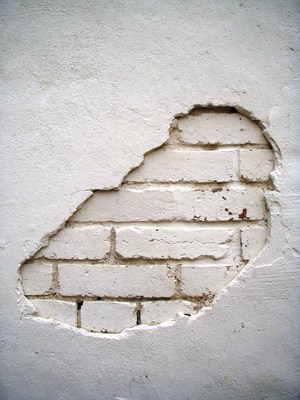Don’t you love plaster walls? When painted and kept in good condition, plaster walls look great and provide a great sound barrier. They’re architecturally significant, especially in older homes. They just feel right in some homes and structures. My old home has plaster walls that are still in good shape. Nonetheless, they need repair and repainting from time to time, which can challenge even the best of good intentions.
Yes indeed, plaster is a beautiful element when it’s kept n good condition. When it’s not, look out. Removing old plaster can be particularly problematic. Old plaster tends to crumble at the slightest touch so best to be careful when approaching this home improvement project. Working with plaster can also be intimidating. If you need to build your confidence, check out This Old House online which has a wonderful online primer on patching plaster walls. Of course, practice makes perfect when working with plaster walls.
Ready to start? Check out these Top 5 Ways to Remove Old Plaster. Sure to prevent plaster problems before they start.
Plaster Tip No. 1. Less is more. The one thing you need to remember about plaster is that there’s more to plaster than meets the eye. If you need to remove it from a wall, best to chisel and chip away in small amounts before trying to remove a large area. Otherwise, if you try to remove too much plaster, you can lose a large section of your wall in the process.
Plaster Tip No. 2.The edges count. Plaster hides a host of problems. Plaster also adheres to what’s behind it. Chip away at the edges before trying to remove a large area of your plaster wall for replacement or repair.
Plaster Tip No. 3. Keep the dust at bay. Patching or repairing plaster is a messy job. Cover as much of the nearby area with plastic, and you’re ahead of the game. Plaster dust is unforgiving. Best to keep everything covered during the repair or replacement.
Plaster Tip No. 4. Know what’s underneath. Plaster that covers bricks and mortar can be easy to remove by chipping away at small places. You don’t risk damaging the wall behind it. Knowing what’s behind the plaster can save you time, effort and money in the long run.
Plaster Tip No. 5. Take your time. Working with plaster, particularly old plaster, takes time and patience. Don’t rush the job and you’ll be happy with the results.
Materials Needed to Repair Plaster Walls
Whether you’re working on a large job or rather small patch, you’ll need a variety of materials and tools to get the job done. Among them,
Plastic, drop cloths and tape
Patching plaster
Joint compound
Curved tool for undercutting
Putty knife or spackling tool
Plaster trowel
Wood (optional)
Consult the home improvement pros at your local hardware store or home improvement center for additional tips and strategies for working with plaster and plaster repairs.
RESOURCES
This Old House
www.thisoldhouse.com
Home and Garden Television (HGTV)
www.hgtv.com
Association of the Wall and Ceiling Industry
www.awci.org






